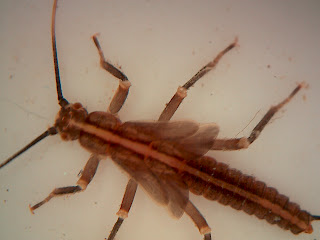 |
| Red-tailed hawk kept watched me as I approached Fleming Creek. |
On Sunday Kee and I enjoyed a stellar visit to Newport Forest. Winter can be a little sleepy, but not yesterday. We started our visit with the usual routine of weather observations and topping up the feeders. Right away there was activity - a chipmunk and cottontail made an appearance followed by a downy and red-bellied woodpecker. A few nuthatches and chickadees soon joined the group.
 |
| Greenside (?) Darter. |
Spurred by a curiosity to know exactly what animal life is active in Fleming Creek in the winter I cautiously crept down to the water to take a small sample. A red-tailed hawk screeched at me as I made my way down the bank. After a few seconds of kicking and sweeping bottom substrate a small fish appeared in the net. Ooh.. Kee will like to see this I thought to myself. It appeared to be a greenside darter - not too brightly coloured at this time of year. I kicked for a few minutes while Kee and I chatted away. The water was not much more than a foot deep, so it was easy to maneuver in my rubber boots. I peaked into my net a few times to see if there was anything squiggling ... no movement. Oh well, I put the apparently lifeless gravel into a peanut jar for further inspection at home. I took a separate grab sample for Kee, who wanted to investigate the oligochaetes (aquatic worms).
 |
| Vocal red squirrel |
Next we wanted to go check out the Thames River. As we made our way along the trail, we noted turkey, meadow vole, and squirrel tracks. With winter dragging on, we noted the increasing effort squirrels have put into removing valuable walnuts from the frozen ground. There were a series of excavations along just off the side of the trail. At the river we saw about 20 Canada Geese, a few Mallards and some turkeys (flying across the river). We also checked three trail cameras, leaving one in place and collecting the others.
Back at the nook a vocal red squirrel greeted us with chattering calls. Emboldened by hunger, the animals took turns visiting the feeder to fill their empty winter bellies. Even a tufted titmouse showed up. I continued to spy birds while Kee set up a trail cam in the trailer, to hopefully capture an image of the weasel which has recently made its presence known (mostly in the form of many droppings). A little while later Kee let me know he was packing up camp for the day. As we drove up to the road 13 turkeys rose from the upper meadow.
Later at home I looked through my peanut butter jar of creek water and mud to find more life than I
originally expected. A few stoneflies (taeniopterygidae and leuctridea families), craneflies, caddisflies (bright green hydropsychidae), fingernail clams, midges and worms thrashed about in the water. I experimented a little with photographing the more interesting specimens (a completely biased selection). John Bittorf helped me identify the Early Black Stonefly Taeniopteryx nivalis, a very common stonefly in the East. He also gifted me a wonderful ID key, which I meant to ask if I could share here. That's a new family for the Newport forest ATBI http://www.csd.uwo.ca/faculty/akd/newport-forest/ref/ATBI.pdf.
 |
Taeniopteryx nivalis |
 |
| Rhyacophilidae |
2 comments:
Sounds like a great day.
You should join us sometime, I think you would like it.
Post a Comment